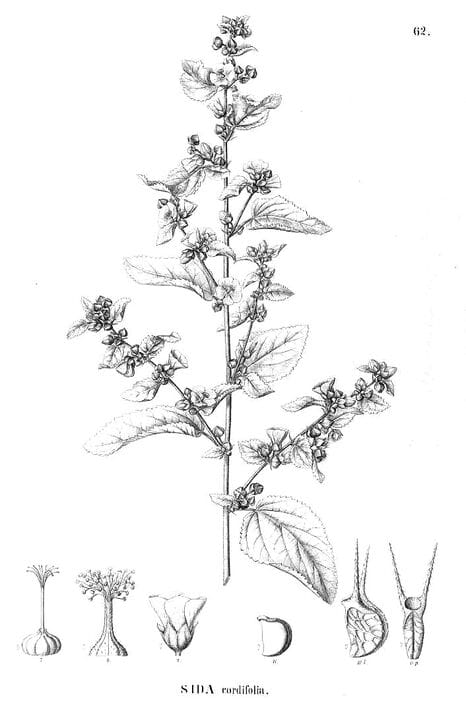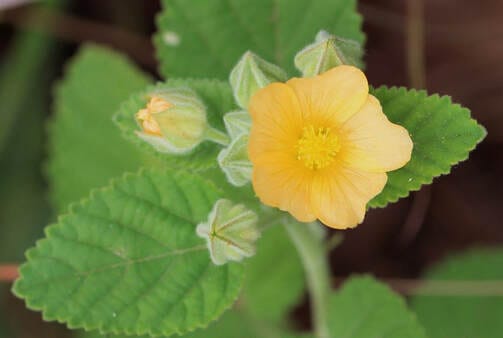Sida, Bala
Indian Country MallowBala (Ayurveda)
Bala, Beej Band (Unani)
Xin Yin Huang Hua Zai (TCM)

Martius, Eichler, Urban, Flora Brasiliensis, 1891
 Sida cordifolia
Sida cordifolia(Photo by Karen Pagel) (Wikimedia)
Botanical name:
Sida cordifolia (syn. Malva tormentosa)
Various species have supplied Bala in the past:
i. Batyalaka: S. cordifolia
ii. Mahabala: S. rhombidea (variety of S. rhombifolia)
iii. Atibala: S. rhombifolia
iv. Nagabala: S. alba
Other Sida species reportedly used include S. acuta, S. spinosa, S. althaefolia, S. alnifolia, S. herbacea, S. lanceolata, S. orientalis, S. retusa
Other plants which have been considered as Bala, or varieties of Bala, or are used as Bala in various parts of India include:
i. Abutilin indicum Atibala, Kangi
ii. Grewia hirsuta, G. populifolia, and G. tenax
iii. Triumfetta rotundifolia
iv. Pavonia odorata, P. zeylanica
Parts used:
Root (rarely the seed or fresh plant juice)
Temperature & Taste:
Cool, moist. Sweet
Uses:
1. Strengthens the Kidneys, Nourishes Yin:
-gives strength, weight-increasing, nourishing; weakness, fatigue, emaciation, convalescence
-increases sexual potency, nourishes Sperm, regarded as Aphrodisiac (root, seed)
–spermatorrhoea, nocturnal pollution, premature ejaculation, and to increase the viscosity of semen (seed, Unani)
-Infertility; strengthens mother and Fetus during Pregnancy
-polyuria, urinary frequency
-increases Essence and is rejuvenative
-low-grade Fever from Yin deficiency
-dry Cough, Tuberculosis, Hemoptysis
2. Clears Heat and Damp, Resists Poison:
-Urinary infection, blood in the urine
-Diarrhea, Dysentery
-Damp-Heat Jaundice (TCM)
3. Clears Heat, Resists Poison:
-Intermittent Fever with cold chills and shivering, followed by stronger heat and Fever
-heat-type Cough; Asthma
-Gonorrhea; Sexually Transmitted Disease
-Carbuncles; Toxic Sores
4. Nourishes Yin, Settles Wind:
-Neuralgia, Sciatica, Paralysis, Facial Paralysis
-Arrhythmia, Tachycardia, Irregular Pulse, Palpitations
-also for Mental Illness
-found useful for Diabetic Neuropathy
5. Clears Heat, Stops Bleeding:
-Bleeding (decoct with milk)
-Excessive Menstrual Bleeding (powder with Honey)
6. Externally:
-external preparations (mostly oils) for arthritis, paralysis, hemiplegia, rheumatism and Vata/Wind diseases.
Dose:
Often taken with, or decocted in, milk; especially to nourish Yin and Essence, increase Fertility and stop Bleeding.
Taken with Almonds is also used to enhance the tonic effect.
Powder: 500mg–3 grams (5 grams daily);
Decoction: 10-15 grams (30-60 grams);
Tincture (1:5 in 25%): 3–15 mls.
Crush and apply topically, or boiled in oil and used topically.
Comment:
Bala is considered Rasayana (tonic) for Vata (Wind) conditions and Constitutions in Ayurveda. Stimulant herbs (such as those containing Ephedrine) usually aggravate Vata (Wind/Qi). But Bala is an exception. Despite containing a small amount of Ephedrine, is a rejuvenative for Vata/Wind constitutions.
Substitutes:
1. In some cases Marshmallow root or Asparagus root can be used.
2. Cough, Wheezing, Asthma, Ephedra can be used; or even better, Ephedra with Marshmallow.
3. In India, Abutilon indicum and Parvonia odorata are accepted substitutes.
Main Combinations:
Frequently combined with Abutilon Atibala in classical Ayurvedic texts.
1. Rejuvenate and regulates Wind constitutions:
i. Sida cordifolia, Chebula with Honey and Ghee
ii. Sida cordifolia with Withania, Chebulic Myrobalan
iii. Sida cordifolia, Chebula, Nutmeg, Aloeswood
2. Urinary frequency or urgency from Heat:
i. Sida cordifolia powder is given with Milk and Sugar
ii. Sida cordifolia with Tribulus seed, Licorice and Coriander seed (Ayurveda)
3. Diarrhea, Sida (6 grams), Black Pepper (2–4 in number)
4. Fever:
i. Intermittent Fever, Sida cordifolia root decocted with Ginger (Unani, Ayurveda)
ii. Sida cordifolia with fresh Ginger, Lemon Grass, Black Pepper
iii. Chronic Fever, Edema, Anemia, Sida cordifolia with Adhatoda (Vasaka), cooked in Ghee (Sushruta)
5. Asthma, Wheezing:
i. Sida cordifolia with Ephedra and Licorice
ii. Sida cordifolia with Long Pepper, Almond
6. Bronchitis with Fever, Sida cordifolia with Solanum indicum (Vrihati), Solanum jacquinii (Kantakari), Adhatoda vasica (Vasaka), Raisins (equal parts, prepared as a decoction)
7. Impotence, Sida cordifolia with Sesame seed, Tinospora (Guduchi), Asparagus racemosa (Shatavari), Mucuna, Emblic Myrobalan (Ashtanga Hridaya)
8. Infertility:
i. Sida cordifolia with Cow Milk (Chakradatta)
ii. Sida cordifolia with Withania, Asparagus Shatavari and Lotus seed (Ayurveda)
9. Paralysis, Facial Paralysis, Parkinsonism:
i. Sida cordifolia with Withania and Mucuna, decocted in Milk (Ayurveda)
ii. to the preceding can be added Hygrophila (Katrina), Vanada (Rasna), all in equal parts (as in Masha Baladi Kvatha)
iii. Facial Paralysis and Sciatica, Sida cordifolia root boiled in sesame oil is applied, the powder is taken with Milk internally.
iv. Parkinson’s, Sida cordifolia, Mucuna, Henbane seed, Withania (this was studied and found to be more effective when used after Ayurvedic cleansing therapies–Panchakarma).
10. Heart disease:
i. Sida cordifolia with Arjuna and Bdellium
i. Sida cordifolia with Arjuna and Sida spinosa (Nagabala), Licorice
11. Mental disorders:
i. Sida cordifolia with Achyranthes aspera and Milk.
ii. Sida cordifolia with Convolvulus Shankapushpi, Withania, Centella
12. Goiter, Sida cordifolia with Abutilon (Atibala), Cedrus deodara wood (Devadaru), boiled in oil and taken internally. (Sushruta)
Cautions:
1. Not used in Phlegm conditions
2. Hypertension
3. Contains Ephedrine (less than 10% of that found in Ephedra).
4. It has been banned in some countries (including the U.S.) due to the Ephedrine content.
Toxicity:
The extract showed low acute toxicity.
–Anti-inflammatory, analgesic activity and acute toxicity of Sida cordifolia L. (Malva-branca).
Drug Interactions:
Due to Ephedrine content, full doses may interact with:
1. Caffeine and MAO inhibitors, increasing blood pressure
2. Beta-Blockers (reduces efficacy due to opposing action)
3. Ephedrine medication (such as Sudafed), causing ephedrine toxicity, arrhythmia etc.
4. Steroids (dexamethasone), enhancing clearance thereby reducing effectiveness.
Main Preparations used:
|
‘The plants belonging to this genus are known in Sanskrit by the general name Bala. Four kinds are mentioned in medical works, namely, Batyalaka (S. cordifolia), Mahabala (2. var of S. rhombifolia), Nagabala (S. spinosa). The Hindus regard the roots of the different species of Sida as cooling, astringent and tonic; they prescribe them in nervous and urinary diseases, and in fever. The root bark is beaten up with milk and sugar, and aromatics and stimulants arc sometimes added. (For original prescriptions, see Dutt’s “Hindu Materia Medica, p.121.) In the Concan the leaves of S. cordifolia (Chikana) with other cooling leaves are applied in ophthalmia; the root-juice is used to promote the healing of wounds, and the juice of the whole plant pounded with a little water is given |
in 1/4 seer doses for spermatorrhoea. The root of S. carpinifolia (Tupkaria) is applied with sparrow’s dung to burst boils. The Mahometans consider Bala to be aphrodisiac. Ainslie notices several species of Sida, and the uses to which they are applied by the Hindus. The authors of the Bengal Dispensatory, after a trial of the roots of Sida carpinifolia, were unable to satisfy themselves as to its febrifuge action, but it was found to promote perspiration, to increase the appetite, and to act as a useful bitter tonic. In Goa the Portuguese value it as a diuretic, especially in rheumatic affections; they also use it as a demulcent in gonorrhoea’. (Vegetable Materia Medica of Western India, Dymock, 1885) |
